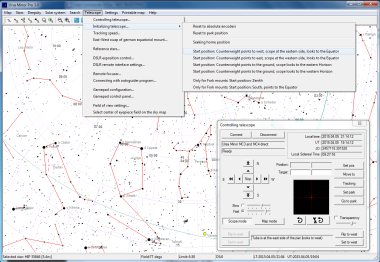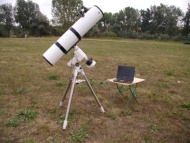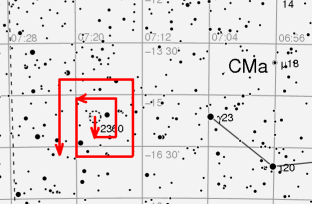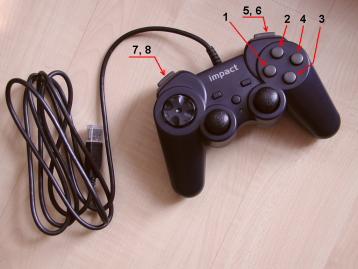Controlling Telescopes with Ursa Minor Software
Goto telescope mounts are becoming more and more popular. Not only do high-end telescopes have computerized control capabilities, but less expensive and simpler mounts now include this capability. These telescopes, after accurately aligned to the north celestial pole, can automatically position the mount to any selected celestial target. These GoTo mounts use a hand controller that is an intelligent device with a built-in astronomical database. While these telescopes can be directed by a hand controller, controlling them with astronomical software from a laptop can be even more convenient and powerful. Because these programs have larger databases, they have more accurate positioning capability. These programs also contain other useful functions, for example observation planners and observing tips, etc.
Ursa Minor Pro software can easily control GoTo telescope mounts. This approach is more convenient than using the original mount hand controller because you can easily choose celestial objects using a single mouse click on a sky map. Additionally, Ursa Minor's database contains far more stars, deep sky objects, minor planets and comets than possible using a hand controller.
After a serial data connection is established between a telescope mount and a computer, the telescope can be directed to any celestial object selected with a mouse click. After the object is located, automatic tracking can be enabled to follow object's virtual movement across the sky.
Supported telescopes
Ursa Minor supports the following telescope controllers and Goto telescopes
- Commercial telescopes with built-in goto function
-
For controlling these telescopes you do not need to install any additional software components such as ASCOM drivers,
etc.
- Fornax mounts
- The default controller for Fornax mounts are the MC3 and MC5 controllers. Ursa Minor has complete support for these controllers.
- Skywatcher EQ6 Pro, HEQ5 Pro, EQ5 GoTo, EQ3 GoTo
- Popular GoTo telescope mounts from Skywatcher. These models are equipped with a Synscan hand controller which contains an RS232 serial port
- Skywatcher HEQ5 Pro, EQ6 Pro, EQ5 GoTo, EQ3 GoTo (direct control)
- Ursa Minor Pro can also control the mounts listed below without use of the original hand controller. In this case a direct connection between the hand controller port on the mount and a serial port on a computer is established. This approach essentially bypasses the hand controller. In these cases the Ursa Minor program provides additional functionality such as locating objects using a spiral line search algorithm, i.e., if the GoTo positioning was not precise enough to place the object in the telescope’s field of view.
- Celestron Nexstar
- Protocol of NexStar models, such as the GT 104 Maksutov-Cassegrain model
- Meade LX200 models
- Controlling telescopes equipped with Meade LX200 compatible telescope controllers
- Controlling Custom heavy-duty mounts and upgrade non-GoTo mounts
-
Some non-GoTo telescope mounts can be modified by adding stepper motors and electronics. When upgraded, these mounts
can then be controlled with Ursa Minor Pro software.
- Custom heavy-duty Mounts
- We recommend MC3 and MC5 controllers for any telescope mounts with stepper motors in the medium-large range.
- EQ6 Syntrek
- The difference between the standard EQ6 mount and the Syntrek version is that the Syntrek version includes Skyscan motors and a different basic hand controller. It does not include the Synscan hand controller but does include an autoguide port. The Syntrek mount can slew up to 800X and includes basic features superior to the standard EQ6 mount. This mount can be controlled with Ursa Minor Pro providing true GoTo functionality.
- Medium sized mounts (EQ3, EQ5, TAL - currently under development)
- The Skywatcher EQ3 and EQ5 mounts may be purchased with faster motors and GoTo features. However, older models with slower motors can also be converted into a GoTo mount. While the positioning speed won't be as fast, these older models provide an inexpensive GoTo alternative. We have also developed an Ursa Minor hand controller product. This is a universal hand controller designed to work with several motors with different gear ratios. It has a USB interface to provide a data connection to a computer. The Ursa Minor Pro program supports this universal hand controller.
Connecting to the telescope, protocols
- Choose the "Telescope / Telescope Control" menu item!
- The "Telescope Control" window appears. This window can be held open during the use of telescope. The other functions of the program remain accessible.
- Click the "Connect" button! The following popup window appear. You can choose the protocol and other connection
settings here.
- Choose the device type and protocol from a drop-down list.
- Choose the COM port. The comport number of the telescope controller connected to the computer can be discovered in Windows Control Panel.
- Choose the Baud rate: Use 115200 Baud for MC5(OC5) and 9600 for all other devices.
- Click the "Connect" button! The program builds up the connection to the device and will be ready soon. The "Ready" message appears in the Telescope Control Window's status field.
From this point you can start use your telescope with the program. The possibilities are depending on the particular telescope controller. The usage of the MC3 and MC5 telescope controllers are described in separate page.
Extra Functions
Using an Autoguider
For long exposure astrophotography imaging, precise guiding is necessary. Most of the popular telescope mounts include an autoguide port. Using this port the mount's motor driver circuit can accept guide correction pulses. The Ursa Minor program has no built-in autoguide function but other programs can provide this functionality working in conjunction with Ursa Minor software.
The Ursa Minor hand controller (GoTo kit for upgrading medium sized mounts) has a built-in autoguide interface. This interface can be connected to a computer USB port and requires no special cable or interface. The hand controller emulates a virtual serial port and accepts Meade LX200 GPS compatible autoguide commands (Pulseguide). This is a very convenient method of autoguiding.
Searching Object on a Spiral Line
Aligning a mount exactly to the celestial pole is not a simple effort. When this alignment is not precise enough, the telescope will not point exactly to a selected object. The difference can be as much as one degree. When a telescope with a small field of view (for example a Maksutov telescope) slews to an object, the target object may be outside the field of view. In this case the Ursa Minor software "Searching on Spiral Line" feature can prove very useful. Selecting this function will slowly move the telescope around a spiral line which enhances the chance that the desired object will appear in the field of view. The image below depicts how the spiral path feature operates.
Using a USB Gamepad
When you use a telescope without a hand controller, using a keyboard and mouse can be challenging. For a more practical approach, Ursa Minor supports standard gamepads. All functions can still use a keyboard and mouse but more important functions, such as positioning and adjusting the slewing speed, can be performed by pressing buttons on a gamepad. You can effectively drive a telescope using a gamepad by keeping your eye on the desired object while pressing the gamepad controls. You can make observations even more comfortable using a wireless (Bluetooth) gamepad. The image below illustrates a common USB port gamepad:
Autoguiding and Controlling a Telescope on a Single Cable
The Ursa Minor program doesn't have a built-in autoguider but it can cooperate with an existing autoguider program. Tested programs are: GuideMaster and PHD guiding. Using a virtual serial port, the autoguider program does not connect to the telescope mount directly but instead connects to the Ursa Minor program. Virtual serial ports function exactly in the same manner as a physical serial port but are emulated in software. The Ursa Minor program will recognize the guiding commands from the autoguider program and send them to the telescope on the same cable that used for GoTo and manual mount control. The result is fewer cables, i.e., a single cable for guiding and telescope control.
As a first step you install a virtual serial port pair driver. This driver emulates a serial port pair and ties them together. One program can then connect to the first port of the pair and another program can connect to the other port. All data sent by the first program will be received by the second program and vice-versa.
You can read information about installing a virtual serial port driver on our Support page.
From the Ursa Minor program, choose the "Telescope/Connecting with Autoguider Program..." menu. A small window will appear. Choose the port number of the first port of the virtual port pair from the drop-down list. Press the Connect button and the Ursa Minor starts listening on the selected port.

Important: Start autoguider monitoring in Ursa Minor before making a connection using the autoguider program.






